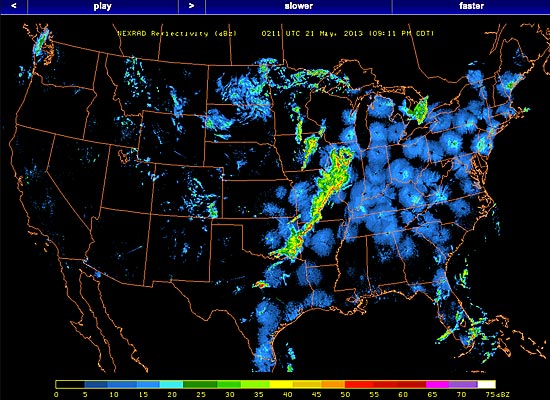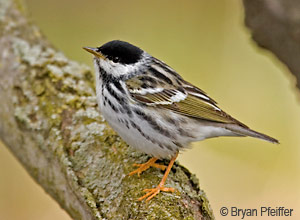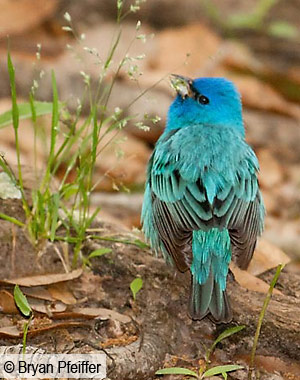The Forecast Calls for Birds

Prothonotary Warbler / © Bryan Pfeiffer
By Bryan on May 22, 2013 (Revised May 7, 2014)
Songbirds pouring from the skies at dawn. Thousands of hawks gliding past a mountain summit. Rare oceanic birds blown in to shore. Birdwatching like this doesn’t necessarily begin when you go outside. It begins with a weather forecast the day before. And it’s why you should go birding during crappy weather in May.
Foul weather can generate spectacular fallouts of birds in spring. Fallout conditions occur when warm air from the south or southwest meets colder air to the north. The collision can produce fog, rain, and swirling winds – weather you might not consider suitable for birdwatching. But these conditions can cause countless birds – migrating north on tailwinds – to drop from migration and into view.
Topography can also be your partner. If they’re over water, migrants seek any port in a storm, which means they will pile up on islands and along peninsulas. When forced into urban areas, songbirds often move to the nearest patch of trees where they find cover and food, which is why Central Park in New York City and Mt. Auburn Cemetery in Boston are legendary spring birding destinations.
During spring fallouts I’ve seen trees glowing with dozens of warblers seeking shelter from wind and rain. I’ve encountered exhausted Scarlet Tanagers at my feet. And I’ve experienced 70 Indigo Buntings in a single thicket. So dense are birds during a genuine fallout that you can point your binoculars in most any direction to find something flitting or flying.
During one dawn rainstorm in Ohio, which produced an epic fallout, I encountered 20 warbler species in my first 20 minutes of birding, which may be my greatest listing feat in nearly four decades of chasing birds. Don’t believe in fallouts? Check out these images of spring warbler fallouts on Machias Seal Island in the Gulf of Maine.
Autumn
It pays to watch the weather in autumn as well. The right conditions for hawkwatching generally feature cold fronts with weak or moderate winds blowing from the north. Hawks move relatively effortlessly on those crisp days in September and October. They rise late morning with thermals of warmer air generated by autumn sun shining into valleys. After reaching sufficient elevation, hawks break out of their thermal and glide south on high tailwinds.
Meanwhile, along the ocean shore, it’s fine to spend a fall day watching eiders, scoters, loons, grebes, gannets, and gulls. But if you want alcids, jeagers, shearwaters, and other odd ocean-going birds, grab your foul-weather gear and get out during a Nor’easter or other weather that generates on-shore winds pushing the rare birds closer to land.
Reading Radar
It’s one thing to know the local forecast when heading afield, it’s another to “see” birds on the way. The National Weather Service’s Next Generation Weather Radar system, NEXRAD, is sensitive enough to detect birds, bats, and occasionally insects in flight. Many songbirds rise together to migrate after sunset, and they’re often dense enough to form distinctive radar patterns that have a different profile than clouds and rain. Migrating birds move faster than prevailing tailwinds, which means the radar patterns, when viewed over time in an animated loop, help confirm that you’re indeed looking at birds in the air and show you the direction of the flight.
 To see what I mean, here’s the NEXRAD radar loop for the United States for the evening of May 20, 2013, probably representing the launch of migrating birds that night and presumably the source of a very good day at Berlin Pond here in Vermont the next morning. As this loop runs, note the explosion of blue imagery that shows up from roughly 8pm to 10pm. Those are most likely birds taking flight for the night. Here to the right is a still shot from 9:11pm on May 20 (or 1:11 UTC on May 21).
To see what I mean, here’s the NEXRAD radar loop for the United States for the evening of May 20, 2013, probably representing the launch of migrating birds that night and presumably the source of a very good day at Berlin Pond here in Vermont the next morning. As this loop runs, note the explosion of blue imagery that shows up from roughly 8pm to 10pm. Those are most likely birds taking flight for the night. Here to the right is a still shot from 9:11pm on May 20 (or 1:11 UTC on May 21).
Reading these online radar images takes some training (I can’t claim to be any good at it), but a few dedicated biologists are watching the radar and the skies, and alerting birders when migrants might be coming. Your best over all bet on birds and weather is BirdCast (“Bird Migration Forecasts in Real Time”). I often consult these:
- A list of NEXRAD Radar Loop Maps from Paul Hurtado’s birding page at Ohio State University.
- A NEXRAD is continental map in real time from the University of Wisconsin.
- A real-time High-Resolution NEXRAD Loop for Northeast from the University of Wisconsin.
- A good source of radar data is National Center for Atmospheric Research.
Birdwatchers need not be slaves to weather – good or bad. Head out for birds any old morning this spring. But also realize that, at the very least, it pays to know which ways the wind blows.



Great report, Bird Diva! Bird on!
I have a ton of Blackpoll Warblers in my backyard…in downtown St. Albans! My “yard” bird list has been insane this week…Scarlet Tanager, Least Flycatcher, Wood Thrush, Nashville Warbler, Magnolia Warbler, Black-throated Green Warbler. Lovin’ it!
Indeed. Might be more good stuff coming:
http://birdcast.info/forecast/regional-migration-forecast-18-24-may-2013/
Let the map images rotate through to Wednesday-Thursday. The map is a bit dated, but you’ll see green (for birds) in northern New England.
That’s what I thought. I saw them there on May 3rd. There was also a Least Sandpiper hanging out with a snapping turtle and green frogs. You and Ruth had a banner birding day!
Great stuff, Emily! I wonder if those Ospreys are nesting.
I thought I spotted a Great Blue on the Winooski, glad to know they’re around again! There are (were) two Osprey at Wrightsville behind the beach visible from the mud flats over the water that connects to Shady Rill. Very exciting!